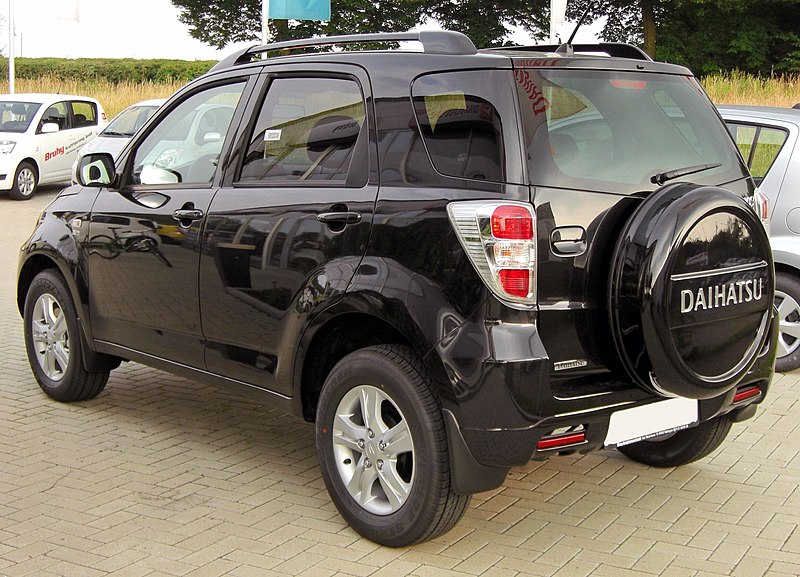Daihatsu Rocky
The Daihatsu Rocky is a mini SUV that was manufactured by Japanese automaker Daihatsu between 1989 and 1998.
It is known as the Daihatsu "Lovibond" Rocky in Japan, as the Daihatsu Feroza in continental Europe, Latin America, Australia, and Asia. It was known as the Daihatsu Sportrak in UK and as the "Rocky" in North Am
To avoid confusion, owners often refer to the models by their factory model number F-300 or F-310. The F-310 variant, marketed as the MkII Sportrak or Feroza II featured a flared guards to accommodate a wider track than the F-300. The F310 was released in 1992, before the later facelift. It had widened suspension, including differentials, and rear leaf springs. The body was kept the same, expect for the wider fender flares and the concealed rear wheel arches, covered by these flares. After this facelift, both the F300 and F310 variations were kept, with differing trim levels and interior design. This is most notable on the materials, colour and pattern of the seats. Both "Rocky" and "Feroza" were also used in various markets on the larger and heavier F75-series.
Daihatsu Terio
The Daihatsu Terios (Japanese: ダイハツ テリオス Daihatsu Teriosu) is a mini SUV, first released in 1997 by the Japanese car manufacturer Daihatsu.
First generation (J100; 1997–2006)
The first generation was available as a five-door estate, and the smaller kei car model called the Terios Kid, which was only released in Japan (see Japanese-language article Terios Kid). Model codes for the first generation were J100, J102, and J122. The Terios Kid arrived in October 1998 and continued to be built six years after the original Terios had been replaced.
In 2000, Daihatsu gave the Terios a mild facelift both in the exterior and interior of the vehicle. A new chrome grille replaced the black plastic grille. The high-grade model gained electric front windows, central locking, rear seat head restraints, alloy wheels, roof rails and a roof-mounted rear spoiler. Mechanically, the 1.3-litre SOHC four-cylinder engine fitted to the previous model had been replaced by the new 1.3-litre DOHC four-cylinder engine. Power was also increased by 3 kW (4 hp). A sport version of the K3-VET engine was produced in Japan.
In Australia, a limited edition sports series was introduced in 2001 with only 200 units being available. The vehicle had body colour matching bumpers, different from the two-tone bumper colour on the standard model. Rear spoiler and sunroof became standard. The interior was updated with metallic paint finish on the centre console and dashboard.
Second generation (J200/F700; 2006–2017)
In European, South American and most other Asian markets, the new model is sold under the name Terios. Daihatsu designed and manufacture the Terios and also supplies the vehicle to Toyota under a consigned/OEM manufacturing agreement.
The second generation known as Daihatsu D-Concept 4x4 made an appearance in November 2005 at the Tokyo Motor Show before being named the new Daihatsu Terios, which went into production in January 2006. Model codes are J200, J210, and J211 for 5-seater version; model codes F700 and F710 for 7-seater version.
The second generation of the Terios is also wider, nearly 1700 mm, compared to the first generation which is less than 1500 mm. The 7-seater version has an increased exterior length to 4425 mm and height of 1745 mm. There are two wheelbase: Short (5-seater only) and Long (5-seater and 7-seater).
Third generation (J300/F800; 2017–present)
The third generation Daihatsu Terios and the second generation Toyota Rush were unveiled and launched in Indonesia on 23 November 2017.The overall design was drastically changed, leaving no traces from its predecessors, such as moving the spare tire to the bottom of the car. They were based on the Daihatsu FT Concept that was first shown at the 2015 Gaikindo Indonesia International Auto Show and the Daihatsu DN Multisix concept car that was first shown at the same show in 2017. Both cars are sold in 7-seater version only. They went on sale on 3 January 2018 with their price starting at Rp 195,2 million (Terios) and Rp 239,9 million (Rush), almost the same price but slightly lower than the previous generation, despite using more features.
The second generation Toyota Rush is available in 2 variant:
1.5 G
1.5 TRD Sportivo
The third generation Daihatsu Terios is available in 4 variant:
1.5 X
1.5 X Deluxe
1.5 R
1.5 R Delu


.jpg/1024px-1990_Daihatsu_Feroza_1.6_EL-II_(F300).jpg)
_SE_hardtop_(2009-10-23)_01.jpg/800px-1992-1993_Daihatsu_Feroza_(F300GD)_SE_hardtop_(2009-10-23)_01.jpg)
_Limited_hardtop_(2015-07-14)_01.jpg/1024px-1997_Daihatsu_Feroza_(F300B)_Limited_hardtop_(2015-07-14)_01.jpg)
_Limited_hardtop_(2015-07-14)_02.jpg/1024px-1997_Daihatsu_Feroza_(F300B)_Limited_hardtop_(2015-07-14)_02.jpg)




%2C_Serdang.jpg/1024px-Perodua_Kembara_(front)%2C_Serdang.jpg)







.jpg/1024px-2018_Daihatsu_Terios_1.5_R_(2018-02-11).jpg)
.jpg/1024px-2018_Toyota_Rush_1.5_TRD_(2018-02-01).jpg)
.jpg/1024px-2018_Toyota_Rush_1.5_TRD_Interior_(2018-02-01).jpg)





.jfif)


No comments:
Post a Comment